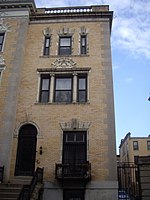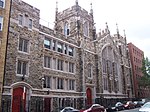St. Nicholas Historic District

The St. Nicholas Historic District, known colloquially as "Striver's Row", is a historic district located on both sides of West 138th and West 139th Streets between Adam Clayton Powell Jr. Boulevard (Seventh Avenue) and Frederick Douglass Boulevard (Eighth Avenue), in the Harlem neighborhood of Upper Manhattan, New York City. It is both a national and a New York City historic district, and consists of row houses and associated buildings designed by three architectural firms and built in 1891–93 by developer David H. King Jr. These are collectively recognized as gems of New York City architecture, and "an outstanding example of late 19th-century urban design":There are three sets of buildings: the red brick and brownstone buildings on the south (even-numbered) side of West 138th Street and at 2350–2354 Adam Clayton Powell Jr. Boulevard were designed by James Brown Lord in the Georgian Revival style; the yellow brick and white limestone with terra cotta trim buildings on the north (odd-numbered) side of 138th and on the south (even-numbered) side of 139th Street and at 2360–2378 Adam Clayton Powell Jr. Boulevard were designed in the Colonial Revival style by Bruce Price and Clarence S. Luce; the dark brick, brownstone and terra cotta buildings on the north (odd-numbered) side of 139th Street and at 2380 Adam Clayton Powell Jr. Boulevard were designed in the Italian Renaissance Revival style by Stanford White of the firm McKim, Mead & White.The district was designated by the New York City Landmarks Preservation Commission in 1967, and was listed on the National Register of Historic Places in 1975. The district's name reflects the nearby St. Nicholas Park.
Excerpt from the Wikipedia article St. Nicholas Historic District (License: CC BY-SA 3.0, Authors, Images).St. Nicholas Historic District
West 138th Street, New York Manhattan
Geographical coordinates (GPS) Address Nearby Places Show on map
Geographical coordinates (GPS)
| Latitude | Longitude |
|---|---|
| N 40.818055555556 ° | E -73.943611111111 ° |
Address
West 138th Street 235
10030 New York, Manhattan
New York, United States
Open on Google Maps









